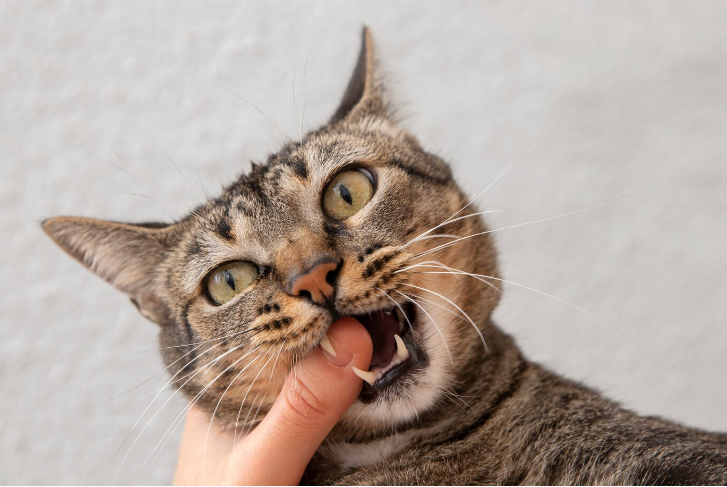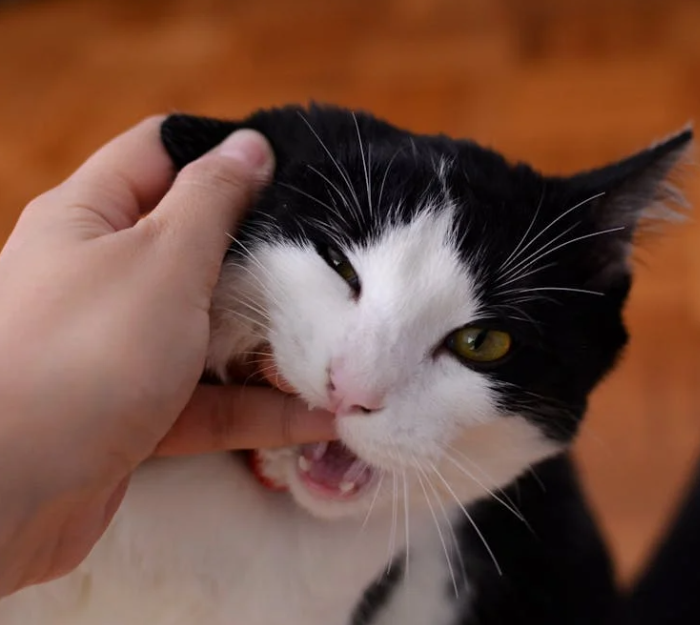2024-06-17
Felines have taken a special place in the hearts of many people! Cat owners always cherish their fur babies in a special way admiring their unique and mysterious nature!
Talking about mysterious nature, sometimes cats display behaviors, like biting, that make their owners wonder “Does my cat really love me?”. Some of you may say that cats do not really love people but rather tolerate them to receive food. Actually, many cats build strong relationships with their owners and get attuned to them and their needs. According to reported cases, some feline representatives can even sense changes in their owners’ emotions and behavior and respond to them.
However, even most loving cat parents can hardly hide their frustration when bitten by their furry friends. If you are wondering why your cat occasionally bites you and how to stop that behavior, you are in the right place!
Today, we will help you find out the reasons behind biting and will give you tips on how to address it properly.
To understand why cats bite, it is essential to be aware of their natural instincts.
Cats are predatory animals by nature, equipped with sharp teeth and claws for hunting and self-defense. In the wild, biting serves as a tool for communication, defense, and also helps cats establish boundaries within their social structure.
While the process of domestication (cats are considered semi-domesticated) has softened some of these instincts, they still persist in varying degrees among house cats.

A common reason why cats bite their owners is playfulness.
Cats, especially while still very young, often engage in playful behaviors that mimic hunting instincts. These behaviors often manifest in stalking, pouncing, and even biting. While their intentions are not likely to be to hurt you in any way, their sharp teeth can inadvertently cause you pain or injure.
Cats who are rather bored and lack sufficient physical and mental stimulation throughout the day, are more likely to bite you during playtime, compared to cats who are physically and mentally fit.
Cats are sensitive creatures, who do not respond well to changes in their surroundings and daily routine. Also they have specific levels of stimulation they can tolerate.
There is a threshold in terms of physical contact and stimulation that varies from cat to cat. As a caring cat parent, you should know your feline very well, including their boundaries, level of tolerance, and signs of overstimulation.
Common signs of overstimulation in cats are vocalization indicating discomfort, such as hissing and even growling, and body language such as flattened ears and dilated pupils. If you notice any of these, you should give your cat space and wait for them to calm down prior to initiating further contact.
Felines who feel handled or petted to intensely and/or roughly may also become overstimulated. This, in turn, will likely lead to defensively biting or scratching (or both).
Similar to humans, cats can also experience fear and anxiety in certain situations.
When feeling threatened or stressed, a natural cat’s response may be to defend themselves through biting. This can occur in various situations, such as during veterinarian visits, encounters with unfamiliar people or animals, or in noisy environments.
Fear and anxiety in cats can be addressed (we will talk about in detail further down in the article). However, felines are individuals, and their own perception of the stimuli in their environment should be taken into account.
Cats are territorial animals, so even if it is your home, your feline may think differently…Cats with strong territorial instincts may perceive not only other pets in the household as intruders but their owners as well.
Territorial cats may use biting as a way to assert dominance and protect their territory.
Having said that, you should carefully consider your paw friend’s temperament before welcoming another pet into your home.

Since we have already listed most common reasons for biting, let’s explore the common solutions for this behavior!
Pay attention to your cat's body language and vocalization, which may indicate that they are feeling stressed, fearful, or overstimulated. As mentioned above, you should give your feline space and let them calm down on their own. Do not force interaction until you make sure your cat is ready for it.
Sometimes the warning signs may be quite subtle to recognize, so you should be attentive to any changes in your paw friend’s behavior and vocalization. This will help prevent the situation from escalating.
Recognizing the warning signs is, of course, helpful to protect yourself from the sharp teeth of your feline. However, recognizing the triggers in your cat’s surroundings and managing them is even more useful! By doing so, you may be able to find the cause of the behavior and prevent it from being displayed.
The stimuli in a cat’s environment can be different and may include sounds (very loud, in particular), other people (especially guests and unfamiliar ones), other pets (especially other cats), changes in the environment or their daily routine, such as diet change, relocating their bedding or supplies, reorganizing furniture, or entirely relocating.
Once you identify your fur friend’s triggers, you can take action which will vary based on the trigger. For instance, you might consider setting up a quiet area for your kitty, so they are isolated from loud noises; putting a playpen; installing blinds to stop your cat from getting agitated from triggers outdoors; gradually introducing the new family member whether it is a baby or another pet; gradually initiating changes at home, including such that concern your cat’s diet and daily routine.
Moreover, you can always rely on desensitization and counter-conditioning as methods to help your pet, whether a cat or dog, change their attitude towards stimuli and get accustomed to them over time. Simply put, you should expose your pet to the triggers by keeping their intensity very low in the beginning and increasing it step by step. While exposing your paw partner to the stimuli, you should reward them with treats (toys and praises also work as secondary reinforcement tools). This will help them associate the triggers with a pleasant experience and not stress.
Last but not least, if you can remove a certain trigger from your cat’s environment entirely, do not hesitate to do so!
Encourage appropriate play behaviors (without biting) by providing your cat with interactive toys and opportunities for physical and mental stimulation.
Also, you should not forget to spend valuable time with your furry friend by engaging in regular play sessions with them and using toys that mimic prey, such as feather wands or laser pointers. They will help redirect their hunting instincts away from your hands or feet.
However, you should be overly careful when incorporating toys featuring small detachable parts, as these can be easily ingested. Always monitor your cat when playing with such toys and make sure there are no loose parts.
By satisfying your paw friend’s need for play and mental stimulation, you can decrease the likelihood of biting out of boredom or frustration.
Establishing clear boundaries with your cat and consistently enforcing them is another tip that can help you address biting!
You should avoid rough or aggressive play that could encourage biting. Gently discourage any unwanted behaviors with a firm "no" instead. Additionally, you might use a redirecting gesture for a bigger effect.
Setting clear boundaries and consistent rules is essential for modifying your cat's behavior and guiding it in the right direction
Remember to never use physical punishment, as this can lead to fear or aggression in your furry friend.
Consistency is a key factor for success, so you should make sure that all family members share the same methodology in terms of raising and training your feline friend.
You should always handle your cat with care and respect their personal space and boundaries.
Avoid rough play and petting them in sensitive areas such as their belly or tail, and be mindful of their body language to prevent overstimulation.
By interacting with your cat with patience and sensitivity, you can build trust and strengthen your bond with them. The frequency of biting and other unwanted behaviors will likely decrease.
Creating a safe and enriching environment for your cat can help alleviate stress and reduce the likelihood of biting.
Ensure your beloved paw friend has their personal space at home and access to essential resources, such as food, water, litter box, and scratching posts. If you have multiple pets, make sure to place their supplies in separate areas at home to prevent competition for resources or territory.
Furthermore, you might provide hiding spots, cozy areas to rest and elevated surfaces where your cat can retreat and feel secure.
Creating a safe and comfortable environment, along with recognizing and addressing potential triggers will help your cat acclimate and stop unwanted behaviors.
If your cat's biting behavior persists despite your efforts to address it, you should consider consulting a veterinarian.
They will conduct an examination that will help identify any underlying medical issues that might cause biting.
If your cat’s veterinarian is also a behaviorist, they can advise you on behavioral modification techniques and environmental adjustments that might help you address this behavior. Alternatively, you might consider seeking assistance by a professional behaviorist.